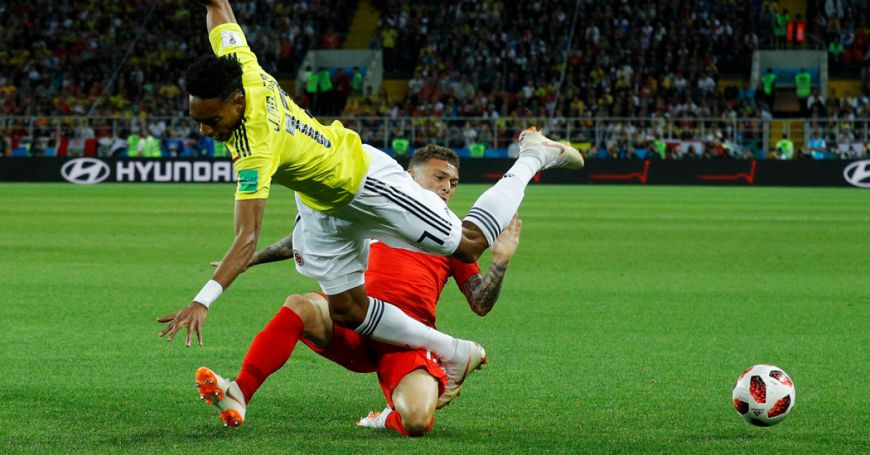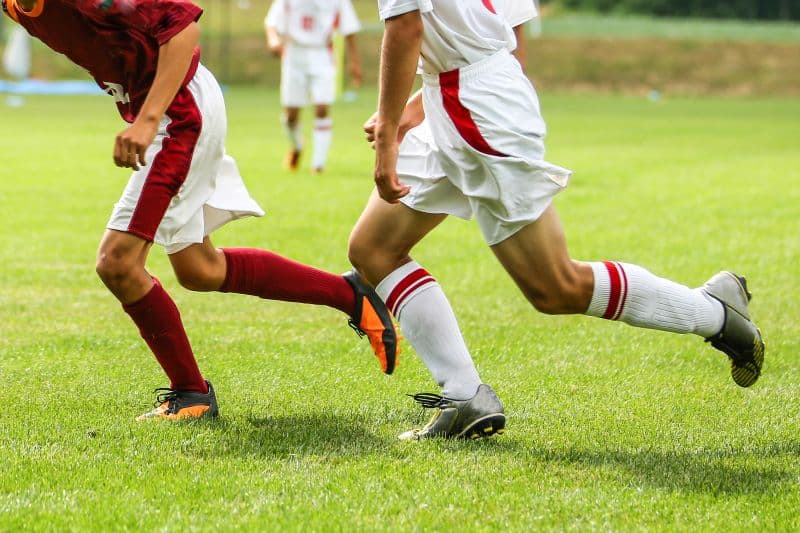Post-Soccer Calf Recovery Tips
maj 20, 2023
Soccer is a game of explosive power and dynamic movement, demanding significant exertion from the lower body, particularly the calves. These muscles are constantly working, propelling you forward, jumping, and abruptly changing direction. While the thrill of the game is undeniable, it’s crucial to prioritize post-game calf recovery to prevent injuries and optimize performance. This comprehensive guide will delve into the science behind calf recovery, present a range of recovery techniques, and equip you with the knowledge to effectively revitalize your tired legs after a soccer match.
Understanding the Calf Muscles and Their Role in Soccer

The calf muscles, specifically the gastrocnemius and soleus, are vital for soccer performance. They are responsible for:
- Plantarflexion: Pointing your toes downwards, crucial for kicking, running, and jumping.
- Ankle stability: Providing support and control to the ankle joint, vital for maintaining balance during fast-paced maneuvers.
- Power generation: Propelling you forward during sprints and providing explosive force for shots and tackles.
During a soccer match, these muscles are subjected to intense repetitive contractions, causing microscopic tears in muscle fibers, leading to muscle soreness and fatigue.
The Role of Eccentric Contractions
Eccentric contractions, where the muscle lengthens under tension, are particularly taxing on the calf muscles. These contractions occur during activities like:
- Landing from jumps
- Decelerating
- Changing directions abruptly
Eccentric contractions cause more significant muscle damage and delayed onset muscle soreness (DOMS), making post-game recovery essential.
Muscle Fatigue and Injury Risk
Fatigue in the calf muscles can compromise ankle stability, increasing the risk of ankle sprains and other lower leg injuries. Recovery techniques help replenish energy stores, reduce inflammation, and promote muscle repair, minimizing the risk of future injuries.
See more: Nhận định bóng đá hôm nay
The Science of Post-Soccer Calf Recovery

Proper post-game recovery focuses on three key aspects:
- Reducing inflammation
- Promoting muscle repair
- Restoring energy levels
Reducing Inflammation
Exercise-induced inflammation is a natural response to muscle damage, but excessive inflammation can prolong recovery time. Post-game recovery techniques that help reduce inflammation include:
- Cold therapy: Applying ice packs or taking contrast baths (alternating between hot and cold water) can constrict blood vessels, reducing inflammation and swelling.
- Compression: Wearing compression socks or wraps can help reduce swelling and promote blood flow, facilitating the removal of metabolic waste products.
- Anti-inflammatory supplements: Supplements like curcumin, omega-3 fatty acids, and tart cherry juice have been shown to have natural anti-inflammatory properties.
Promoting Muscle Repair
To facilitate muscle repair and rebuild damaged fibers, consider the following:
- Proper nutrition: Consuming adequate protein, carbohydrates, and essential nutrients is crucial for muscle recovery and synthesis.
- Foam rolling and massage: These techniques help break up adhesions and knots in the muscle fibers, promoting blood flow and facilitating the removal of metabolic waste products.
- Active recovery: Low-intensity exercises like cycling or light jogging can increase blood flow to the muscles, delivering nutrients and removing metabolic byproducts.
Restoring Energy Levels
Soccer matches deplete energy stores in the calf muscles, making it essential to replenish them for optimal recovery:
- Hydration: Drinking plenty of fluids, especially electrolyte-rich drinks, can help replace lost fluids and electrolytes.
- Carbohydrate replenishment: Consuming carbohydrates within 30 minutes of the match can help restore glycogen levels in the muscles.
- Sleep and rest: Adequate sleep and rest allow the body to recover and replenish energy stores more effectively.
See more: nhan dinh bong da
Effective Calf Recovery Techniques

Foam Rolling
Foam rolling is an effective self-myofascial release technique that can aid in calf recovery. By applying pressure to the calf muscles with a foam roller, you can:
- Break up adhesions and knots in the muscle fibers
- Increase blood flow and circulation
- Promote the removal of metabolic waste products
To foam roll your calves effectively:
- Sit on the floor with your legs extended in front of you.
- Place the foam roller under your calves, just below the knee.
- Cross your other leg over the top of the one you’re rolling.
- Roll back and forth, applying pressure to the calf muscles.
- Pause and hold on any tender or tight spots for 30-60 seconds.
- Repeat for 2-3 minutes on each leg.
Static Stretching
Static stretching can help lengthen and relax the calf muscles, reducing tightness and promoting recovery. Here are some effective calf stretches:
- Standing Calf Stretch:
- Stand facing a wall, with your hands against the wall for support.
- Step back with one leg, keeping the heel on the ground and the knee straight.
- Lean forward, feeling the stretch in the calf of the back leg.
- Hold for 30-60 seconds, then switch legs.
- Seated Calf Stretch:
- Sit on the floor with one leg extended and the other bent, with the sole of the foot against the inner thigh.
- Reach forward and grab the toes of the extended leg, gently pulling them towards you.
- Feel the stretch in the calf of the extended leg.
- Hold for 30-60 seconds, then switch legs.
- Wall Calf Stretch:
- Stand facing a wall, with your hands against the wall for support.
- Step back with one leg, keeping both heels on the ground.
- Bend the front knee while keeping the back leg straight, feeling the stretch in the calf of the back leg.
- Hold for 30-60 seconds, then switch legs.
Contrast Baths
Contrast baths involve alternating between hot and cold water immersion, which can help reduce inflammation and promote blood flow. Here’s how to do it:
- Fill two tubs or buckets, one with cold water (10-15°C) and the other with warm water (38-40°C).
- Start by immersing your calves in the cold water for 2-3 minutes.
- Switch to the warm water for 1-2 minutes.
- Repeat this cycle 3-4 times, finishing with cold water.
- Dry your legs thoroughly after the final cold immersion.
Compression Therapy
Wearing compression socks or wraps can help reduce swelling and promote blood flow, aiding in calf recovery. Here’s how to use compression therapy effectively:
- Choose compression socks or wraps that provide 20-30 mmHg of graduated compression, with the highest compression at the ankles and gradually decreasing up the calf.
- Wear the compression garments for at least 30 minutes after the match or during recovery sessions.
- Remove the compression garments if you experience tingling, numbness, or increased pain.
Active Recovery
Active recovery involves low-intensity exercises that promote blood flow and facilitate the removal of metabolic waste products. Here are some effective active recovery techniques for calf recovery:
- Cycling: Low-intensity cycling can increase blood flow to the calf muscles while minimizing additional stress.
- Light jogging: A gentle 10-15 minute jog can help flush out metabolic byproducts and promote recovery.
- Calf raises: Perform controlled calf raises to gently activate and pump the calf muscles, promoting blood flow.
Nutrition and Supplementation
Proper nutrition and supplementation can aid in calf recovery by providing the necessary building blocks for muscle repair and reducing inflammation:
- Protein: Consume high-quality protein sources like lean meats, eggs, or plant-based proteins to support muscle repair and recovery.
- Carbohydrates: Replenish glycogen stores by consuming complex carbohydrates like whole grains, fruits, and vegetables.
- Anti-inflammatory supplements: Consider taking supplements like curcumin, omega-3 fatty acids, or tart cherry juice to reduce inflammation.
- Hydration: Drink plenty of water and electrolyte-rich beverages to replace fluids lost during the match.
Conclusion
Prioritizing post-soccer calf recovery is essential for preventing injuries, reducing muscle soreness, and maintaining optimal performance. By incorporating techniques like foam rolling, static stretching, contrast baths, compression therapy, active recovery, and proper nutrition, you can effectively revitalize your tired calf muscles after a demanding match. Remember, recovery is an integral part of the training process, and investing time and effort in recovery strategies will ultimately benefit your overall athletic performance and longevity in the sport. So, make sure to listen to your body, give your calves the attention they deserve, and implement these recovery techniques to keep them strong, healthy, and ready for the next game. Your calves will thank you, and your performance on the field will reflect the care and dedication you put into your post-soccer recovery routine. Stay proactive, stay consistent, and watch your calf muscles thrive!
